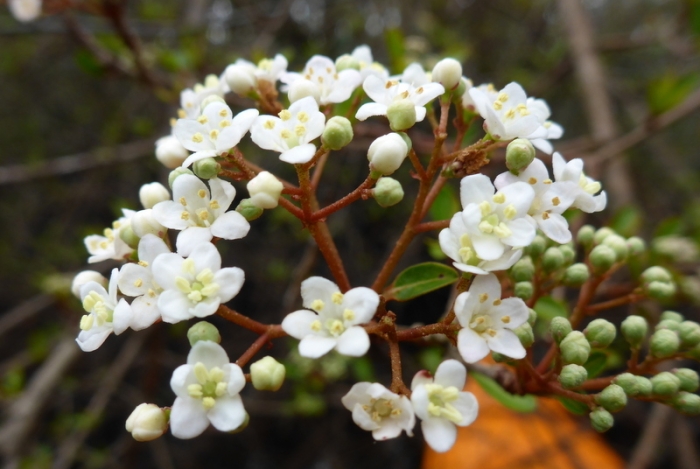Small-Leaf Arrowwood
(Viburnum obovatum)
Small-Leaf Arrowwood (Viburnum obovatum)
/
/

mfeaver
CC BY 4.0
Image By:
mfeaver
Recorded By:
Copyright:
CC BY 4.0
Copyright Notice:
Photo by: mfeaver | License Type: CC BY 4.0 | License URL: http://creativecommons.org/licenses/by/4.0/ | Rights Holder: mfeaver | Publisher: iNaturalist | Date Created: 2019-02-04T13:24:51-08:00 |






















































Estimated Native Range
Summary
Viburnum obovatum, commonly known as Small-leaf Arrowwood, is a deciduous shrub native to the understory of pine flatwoods, hammocks, and moist woodlands in the Southeastern United States. It typically grows to a height and width of 5-12 feet (1.5-3.7 meters), featuring a rounded form with multiple stems. The leaves are small, glossy, and obovate with serrated margins. Small-leaf Arrowwood produces clusters of creamy white flowers in the spring, which are moderately showy and attract pollinators. Following flowering, it bears dark blue to black berries that are popular with birds and other wildlife.
This shrub is valued for its versatility and durability in the landscape, tolerating a range of conditions from full sun to part shade. It is well-suited for use in naturalistic plantings, as a hedge or screen, and in rain gardens due to its adaptability to wet soils. While it prefers medium to wet, well-drained soils, it is also drought-tolerant once established. Small-leaf Arrowwood can be pruned to maintain a desired shape and size, making it an excellent choice for residential gardens. Potential problems include viburnum leaf beetle and fungal diseases, though these are not typically severe.CC BY-SA 4.0
This shrub is valued for its versatility and durability in the landscape, tolerating a range of conditions from full sun to part shade. It is well-suited for use in naturalistic plantings, as a hedge or screen, and in rain gardens due to its adaptability to wet soils. While it prefers medium to wet, well-drained soils, it is also drought-tolerant once established. Small-leaf Arrowwood can be pruned to maintain a desired shape and size, making it an excellent choice for residential gardens. Potential problems include viburnum leaf beetle and fungal diseases, though these are not typically severe.CC BY-SA 4.0
Plant Description
- Plant Type: Shrub
- Height: 5-12 feet
- Width: 5-12 feet
- Growth Rate: Moderate
- Flower Color: White
- Flowering Season: Spring, Summer
- Leaf Retention: Deciduous
Growth Requirements
- Sun: Full Sun, Part Shade
- Water: Medium
- Drainage: Fast, Medium
Common Uses
Bee Garden, Bird Garden, Border Plant, Butterfly Garden, Deer Resistant, Drought Tolerant, Erosion Control, Fragrant, Hedges, Hummingbird Garden, Low Maintenance, Potted Plant, Rabbit Resistant, Salt Tolerant, Showy Flowers, Street Planting
Natural Habitat
Understory of pine flatwoods, hammocks, and moist woodlands in the Southeastern United States
Other Names
Common Names: Walter’s Viburnum , Small Leaf Viburnum
Scientific Names: Viburnum obovatum , Viburnum lanceolatum , Viburnum nashii
GBIF Accepted Name: Viburnum obovatum Walter